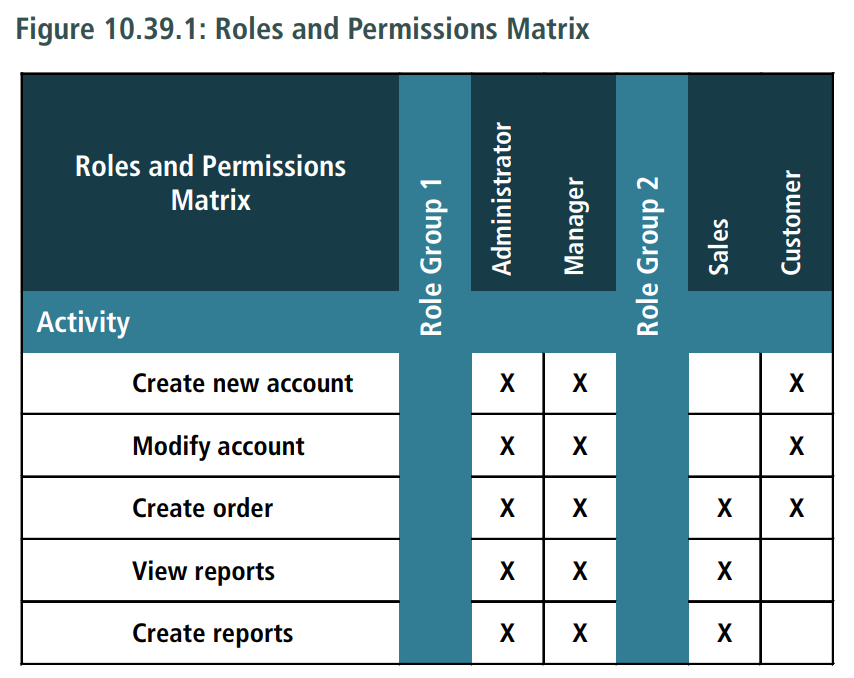10.39.1 Purpose
A roles and permissions matrix is used to ensure coverage of activities by denoting responsibility, to identify roles, to discover missing roles, and to communicate results of a planned change.
10.39.2 Description
Role and permission allocation involves identifying roles, associating these with solution activities, and then denoting authorities who can perform these activities. A role is a label for a group of individuals who share common functions.
Each function is portrayed as one or more solution activities. A single activity can be associated with one or more roles by designating authorities. Each individual that is assigned this authority can perform the associated activity.
The following is an example of a roles and permissions matrix for a software system.

10.39.3 Elements
.1 Identifying Roles
To identify roles for either internal or external stakeholders, business analysts:
- review any organizational models, job descriptions, procedure manuals, and system user guides, and
- meet with stakeholders to uncover additional roles.
Through this review and discussion, the business analyst considers both that individuals with the same job title may have different roles and that individuals with different job titles may have the same roles.
When identifying roles, business analysts look for common functions that are performed by individuals with similar needs.
.2 Identifying Activities
Business analysts frequently use functional decomposition to break down each function into sub-parts, process modelling to better understand the workflow and division of work among users, and use cases to represent tasks. By performing these techniques, the business analyst can ensure that all functions are accounted for and their activities are identified among various use case scenarios.
There may be different levels of abstraction for roles and permission matrices based on the business analysis perspective. Initiative level roles and responsibilities may be identified in a RACI (Responsible, Accountable, Consulted, Informed) matrix. Specific information technology system roles and responsibilities may be identified in a CRUD (Create, Read, Update, and Delete) matrix.
.3 Identifying Authorities
Authorities are actions that identified roles are permitted to perform. For each activity, the business analyst identifies the authorities for each role. When identifying authorities, business analysts consider the level of security needed and how the work flows through the process. Business analysts collaborate with stakeholders to validate identified authorities.
.4 Refinements
Delegations
The business analyst may also identify which authorities can be delegated by one individual to another on a short-term or permanent basis.
Inheritances
Stakeholders may request that when an individual is assigned an authority at an organizational hierarchy level that this assignment pertain to only that user’s organizational level and any subsidiary organizational unit levels.
10.39.4 Usage Considerations
.1 Strengths
- Provides procedural checks and balances, as well as data security, by restricting individuals from performing certain actions.
- Promotes improved review of transaction history, in that audit logs can capture details about any assigned authorities at the time.
- Provides documented roles and responsibilities for activities.
.2 Limitations
- Need to recognize the required level of detail for a specific initiative or activity; too much detail can be time-consuming and not provide value, too little detail can exclude necessary roles or responsibilities.
